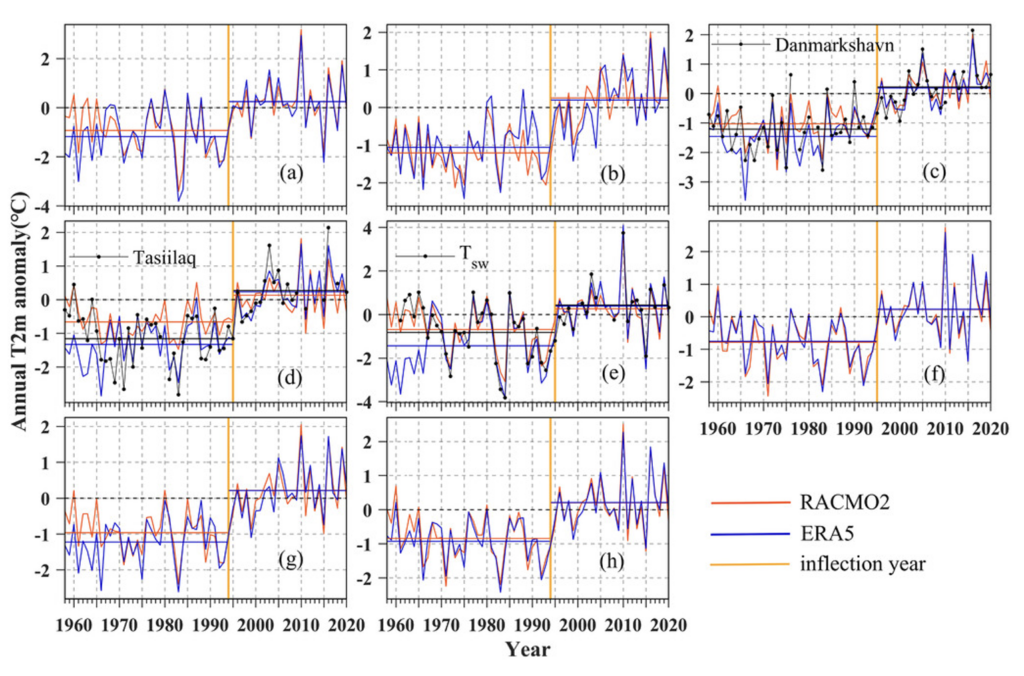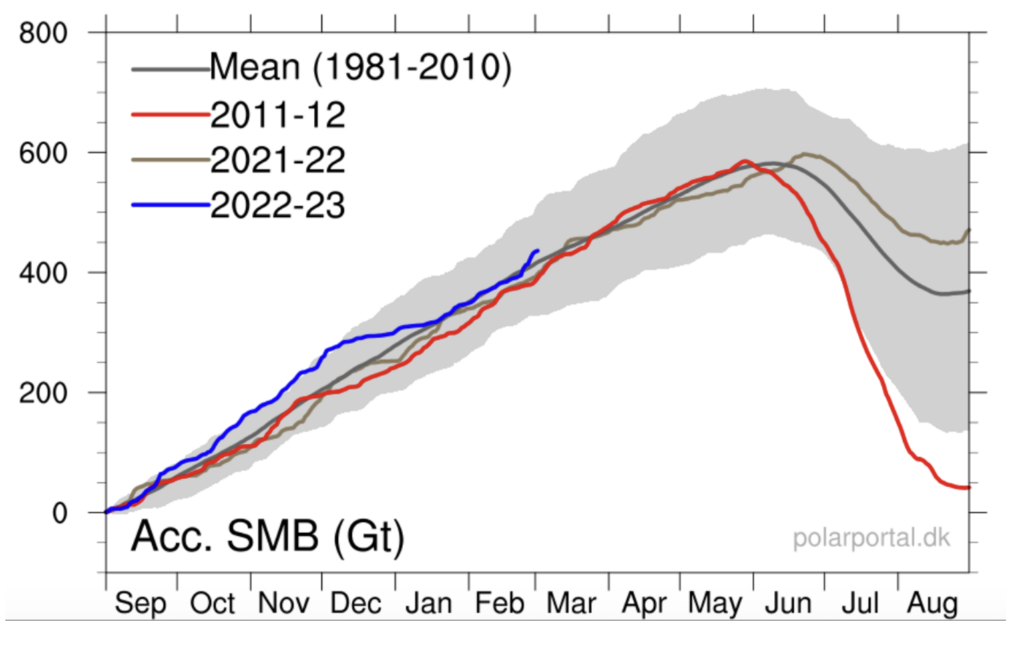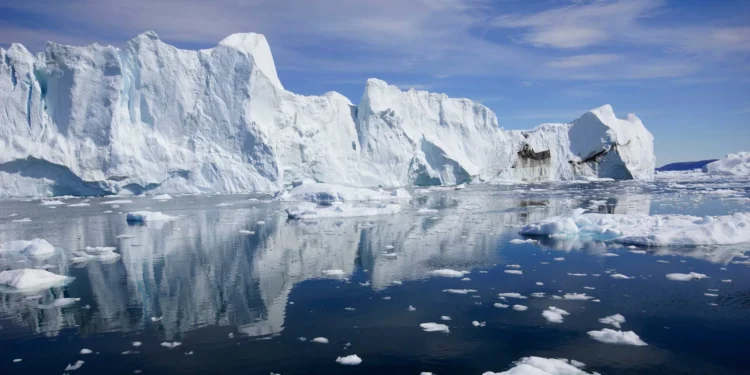Fascinating new scientific evidence has emerged showing stable temperatures in Greenland for at least 60 years, with just a sudden 1°C jump around 1994. The recent findings from a group of environmental meteorologists will cast further doubt on the unproven hypothesis that humans have caused recent changes in the Arctic climate. In a highly detailed paper, the scientists show that the climate changes can be attributed to natural variation caused by two significant air currents.
The scientists report a significant jump in Greenland’s near-surface air temperatures (T2m) around 1994, with relatively stable temperature in the periods before (1958-93) and after (1994-2020). In a crucial finding, the scientists state: “Large scale atmospheric circulation variability can effectively explain this interdecadal variability of Greenland T2m.” These are caused by the North Atlantic Oscillation (NAO) and the Greenland Blocking Index (GBI). The NAO is caused by latitudinal differences in air pressure, while the GBI is a ridge of northern high pressure that leads to troughing in the jet stream. The correlations of temperatures with movements in the NAO and GBI were found to be “highly significant”. Against the background to the sudden 1994 rapid warming, the observed shift in both NAO and GBI was noted to be “critical to the sudden warming in Greenland since the mid-1990s”.
The key set of temperature graphs is shown below.

These graphs show the temperature record for six areas of Greenland with (g) the coastal record and (h) all the country. Stability is generally shown over all areas apart from the sudden jump around 1994. All show cooling until the 1990s, although the north warmed slightly earlier than the south. The magnitude of the temperature jump in 1994 is said to show a clear north-south difference, becoming progressively greater with increasing latitude.
The evidence presented in this paper undermines the ‘settled’ science dogma that blames all or most recent changes in global temperatures on the properties of just one trace atmospheric gas. A gas, carbon dioxide, for which humans themselves are only responsible for 4% of annual atmospheric emissions. MIT Emeritus Professor Richard Lindzen has long argued that temperature changes are caused by dynamic heat flows in the atmosphere and oceans caused by latitudinal differences. Changes in average temperature “are primarily due to changes in the tropic-to-pole difference and not to changes in the greenhouse effect”, he says. Over millennia, the temperature at the tropics has remained little changed, a situation observed in the current record.
The Arctic has warmed in recent times at a rate faster than the rest of the planet, although as we can see, in the case of Greenland, the average is almost entirely due to one annual jump 29 years ago. This warming has been leapt on as incontrovertible proof of anthropogenic climate change. It is of course no such thing, not least because there is increasing evidence that such warming is caused by natural forces. The global warming hypothesis that it is all caused by humans remains unproven, without a single credible scientific paper to say otherwise. Professor Lindzen puts it more bluntly, noting that the present “absurd scientific narrative” leaves us with a quasi-religious movement with a constant “Goebellian repetition by the media of climate alarmism”.
It is unlikely that the mainstream media will stop catastrophising climatic conditions in the Arctic any time soon, since it remains a formidable scare tactic in the collectivist push towards a command-and-control Net Zero agenda. But it is becoming an increasingly difficult hunting ground. Arctic summer sea ice stopped declining 12 years ago, while the Greenland ice sheet might have increased in size to August 2022 if allowance is made for margins of error.
In her latest polar wildlife report for the Global Warming Policy Foundation, the evolutionary biologist Dr. Susan Crockford notes that life at both the top and bottom of the Earth is “thriving”. Arctic sea ice has long been known to be cyclical. There was a downturn beginning in 1979, but that has been broken by a largely unpublicised slow recovery from around 2010. Crockford noted that less summer ice has led to more food for all animals. Polar bears, seals, whales and penguins in Antarctica have all increased in number in recent years.
Finally, let’s check in on the Greenland ice sheet.

Not too shabby, if you enjoy your ice. The top blue line shows the increase in ice so far this winter and reveals further big improvements. In fact it is ahead of averages between 1981-2010, the low point being around 2011-12, and better than last year’s recovery. To August 2022, there was a massive annual increase of 471 billion tonnes created on the surface, compared to the estimated loss of around 500 billion tonnes. It was the 10th highest increase in 42 years and continued a recent recovery, particularly that seen in 2017 and 2018 when over 500 billion tonnes were created on the surface.
Chris Morrison is the Daily Sceptic’s Environment Editor.













To join in with the discussion please make a donation to The Daily Sceptic.
Profanity and abuse will be removed and may lead to a permanent ban.
Good and interesting article, but its preaching to the choir. This new insight will be buried as disinformation, like the others, because climate emergency has nothing to do with climate.
Plant food has zero to do with much of anything, including Arctic Ice. Honestly, what moron believes that a trace chemical causes ice sheets to melt or bears to die?
As with Rona, facts, reality and truth are denied by the mass of the hoi polloi. If the idiot box, and their fake news broadsheet says the Arctic has melted and the bears are dead, that is the ‘$cience’ for most. As long as magic words are used (consensus, experts, models, unprecedented, catastrophic, insert_big sciency_words_here).
oakshott’s partner in crime Tice believes in Net Zero
He believes in what will bring him the most votes.
Perfectly said, and describes most of my extended (not immediate, who have functioning brains) family, acquaintances, ex-friends.
They’ll say let’s destroy the economy, just in case.
Stand in the Park Make friends & keep sane
Sundays 10.30am to 11.30am
Elms Field
near Everyman Cinema & play area
Wokingham RG40 2FE
“One has to free oneself from the illusion that climate policy is environmental policy anymore. We redistribute the worlds wealth de fact by climate policy” —Ottmar Edenhofer (Lead Author at The United Nations Intergovernmental Panel on Climate Change). So what does he mean? Surely global warming is all about humans heating the planet up, not about wealth.————- Well there is the theory that CO2 warms the planet but Climatologist Judith Curry had this to say about that. “Sure, all things being equal, CO2 may cause a little bit of warming, but all things in Earths Climate are not equal”. So maybe we have a little bit of warming, but is a little bit of warming a “climate emergency”? Governments today are more untrusted than ever before. No one believes a word they say. People see politicians as being self serving, agenda driven people who spend more time pandering to the UN/WEF than to the people who actually voted for them, which brings us back to the IPCC. This is the supposed 2000 or so of the worlds “top scientists”. Except it is nothing of the sort. It is full of bureaucrats and government people who are the ones who actually write the Assessment reports that governments around the world base energy policy on.——– So CO2 is a greenhouse gas and it may cause a little bit of warming, but it is also something else. It is the one gas that can be directly tied to Industrial Capitalism. The wealthiest people emit the most for obvious reasons. They have the biggest houses, the most cars and appliances, they travel more and fly more, so they emit more CO2 than poor people do. A carbon tax allows governments to take money from wealthier people and also wealthier countries and redistribute that wealth to poorer people, with the government taking its cut. So we can get a better idea what Edenhofer was meaning when he said “We redistribute the worlds wealth by climate policy”. The same people that think that government are not to be trusted and don’t believe a word they say somehow or other believe everything they say on the issue of “climate change”. WHY. ——Well the main reason is mainstream media who are no longer Investigative Journalists. They are simply bought and paid for climate activists presenting this narrative that humas are causing dangerous changes to the climate and “all scientists say so” so it must be true. ———-Wakey Wakey. You are being played people. This is not about the climate. Edenhoffer of the IPCC told you that. If you don’t believe government on other issues then why believe them on climate? The IPCC, where all of this emanates from is not a scientific body , it is a political one, and it’s final conclusions are all political . Climate Change is politics. The politics of the United Nations Sustainable Development, and our own politicians of all major parties are fully onboard with that, which is why NET ZERO was simply waved through parliament with no questions asked.
Interesting quote from Ottmar Edenhofer. If he were alive today, Ambrose Bierce would have a new definition in The Devil’s Dictionary: Net Zero – “Redistributing the world’s wealth by climate policy”.
Mankind is just virtue signalling, its the latest trend! In victorian times you planted an avenue of trees so your name would be remembered for eternity! Nowadays you have to be the most moral in a pack of moral arseholes, and to hell with the present, your good name depends upon what future peoples will remember you for!
The so called people that are doing this (sadiq kahn, Matt Hancock, david Attenborough and the like)
Are self obsessed with their own virtue, what does the planet matter to them?
Don’t touch our cars!
Looking around the MSM and Twitter etc. the aspect of net-zero that is winding people up is cars. It seems to be a sort of Top-Gear factor, talk about climate change and net-zero was all very well but suddenly it is clear that this is going to have an effect on our cars and that is a step too far. Many people cannot conceive of a life without cars and are starting to realise that if the UK goes totally EV then many people will no longer have a car and people find that prospect terrifying and unimaginable.
And so, whilst this article is excellent and we need to keep stacking up the evidence, if we are looking for where the challenge to net-zero will come from I do feel that cars will play an important factor. I have read that given current technology and resources the world as a whole cannot hope to replace more than 15-20% of ICE cars with EV cars, if that is correct then we need to ensure that people are not deceived into thinking that a shiny Tesla awaits them, more likely standing at a bus stop in the rain. At which point they may start to be prepared to look at the sort of evidence presented in this article.
Make no mistake. NET ZERO means less of everything (including our cars ofcourse). Government have no idea how it can be achieved or how much it will cost. Though it is estimated to be about one and a half to two trillion quid, and who will pay for it?—-YOU WILL ————— Who in their right mind does something like that? The answer is self serving governments that no longer work for the people who vote for them and who now pander to every UN or WEF directive. Carbon emissions represent wealth. The wealthiest countries emit the most. The wealthy west has according to United nations politics used up more than it’s fair share of the fossil fuels in the ground and must stop and our squirming politicians are all fully on board with that and are in the business of taking that prosperity away with the feeble excuse that we need to “save the planet”. But as someone once pointed out “The urge to save humanity is almost always a false face for the urge to rule it”
This article fits nicely under here & draws together a number of threads of the current global events.
https://electroverse.co/californians-snow-stranded-mallorca-hit-by-13-feet-uk-set-for-powerful-long-lasting-arctic-outbreak-all-as-co2-emissions-hit-record-high/
It’s really simple, all of the AGW doesn’t exist evidence needs to be fed to the warmists’ fundaments live on air with the aid of a mallet.
Then the billionaires that fund this nonsense need similar treatment at the skull/tent-peg interface.